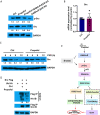Propofol enhances stem-like properties of glioma via GABAAR-dependent Src modulation of ZDHHC5-EZH2 palmitoylation mechanism
- PMID: 35927718
- PMCID: PMC9351178
- DOI: 10.1186/s13287-022-03087-5
Propofol enhances stem-like properties of glioma via GABAAR-dependent Src modulation of ZDHHC5-EZH2 palmitoylation mechanism
Abstract
Background: Propofol is a commonly used anesthetic. However, its effects on glioma growth and recurrence remain largely unknown.
Methods: The effect of propofol on glioma growth was demonstrated by a series of in vitro and in vivo experiments (spheroidal formation assay, western blotting, and xenograft model). The acyl-biotin exchange method and liquid chromatography-mass spectrometry assays identified palmitoylation proteins mediated by the domain containing the Asp-His-His-Cys family. Western blotting, co-immunoprecipitation, quantitative real-time polymerase chain reaction, co-immunoprecipitation, chromatin immunoprecipitation, and luciferase reporter assays were used to explore the mechanisms of the γ-aminobutyric acid receptor (GABAAR)/Src/ZDHHC5/EZH2 signaling axis in the effects of propofol on glioma stem cells (GSCs).
Results: We found that treatment with a standard dose of propofol promoted glioma growth in nude mice compared with control or low-dose propofol. Propofol-treated GSCs also led to larger tumor growth in nude mice than did vector-treated tumors. Mechanistically, propofol enhances the stem-like properties of gliomas through GABAAR to increase Src expression, thereby enhancing the palmitoylation of ZDHHC5-mediated EZH2 and Oct4 expression.
Conclusion: These results demonstrate that propofol may promote glioma growth through the GABAAR-Src-ZDHHC5-EZH2 mechanism and are helpful in guiding the clinical use of propofol to obtain a better patient prognosis after the surgical resection of tumors.
Keywords: EZH2; GABAAR; Glioma stem cells; Propofol; Src; ZDHHC5.
© 2022. The Author(s).
Conflict of interest statement
The authors declare no conflicts of interest.
Figures





References
-
- Irwin MG, Chung CKE, Ip KY, Wiles MD. Influence of propofol-based total intravenous anaesthesia on peri-operative outcome measures: a narrative review. Anaesthesia. 2020;75(Suppl 1):e90–e100. - PubMed
Publication types
MeSH terms
Substances
LinkOut - more resources
Full Text Sources
Miscellaneous

